Feast days of Our Lady
 |
 |
 |
 |
 |
 |
 |
Our Lady of the Miraculous Medal
- November 27
Today is the day of Our Lady of the Miraculous Medal. On this day in the year 1830 Our Lady appeared to St. Catharine Labouré in Paris and revealed to her the design of the Miraculous Medal. As this revelation became known, it was verified that the Miraculous Medal was the agent for an enormous number of extraordinary conversions, which were duly recorded in official documents, demonstrating that this devotion was very desired by Our Lady.
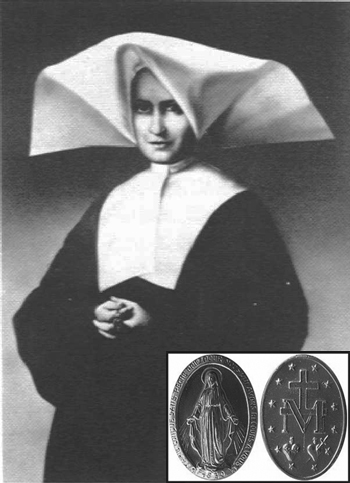 For this reason an excellent custom was established of placing a Miraculous Medal as the center piece of the Rosary. This devotion prepared souls for the definition of one of the most important Marian dogmas: the Immaculate Conception.
For this reason an excellent custom was established of placing a Miraculous Medal as the center piece of the Rosary. This devotion prepared souls for the definition of one of the most important Marian dogmas: the Immaculate Conception.
It is, therefore, worthwhile for us to analyze the Medal and all that it symbolizes so that we may understand what Divine Providence had in mind when It bestowed so many graces on this Medal revealed to St. Catherine Labouré.
On one side of the Medal we have Our Lady standing atop the world, which is an affirmation of her Queenship over the entire Earth.
This same doctrine of the Queenship of Our Lady was re-affirmed at Fatima as a victory of the Counter-Revolution: "Russia will spread her error everywhere; the Pope will have much to suffer; the Church will be persecuted; finally, My Immaculate Heart will triumph." The Revolution will be defeated and we will have the victory of the Immaculate Heart of Mary.
Our Lady is also trampling on the Serpent, which is entirely coherent with the message of Fatima.
On this side of the Medal these words are written: "O Mary conceived without sin, pray for us who have recourse to Thou." This evidently refers to the Immaculate Conception.
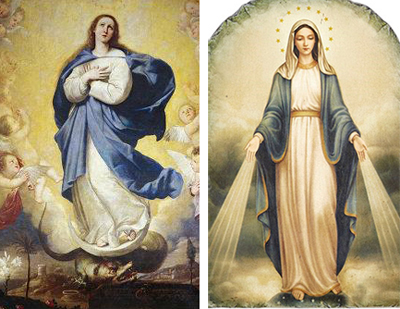 But there is more. In the image of Our Lady she appears somewhat different from the traditional images of the Immaculate Conception as such. On the medal Our Lady has her hands extended and open in a gesture of bequeathing, and from her hands gush rays of light, which are the favors, the graces she gives to the world.
But there is more. In the image of Our Lady she appears somewhat different from the traditional images of the Immaculate Conception as such. On the medal Our Lady has her hands extended and open in a gesture of bequeathing, and from her hands gush rays of light, which are the favors, the graces she gives to the world.
Then, we have something that makes us think of the Universal Mediation of Our Lady. The graces come from God, but are all distributed through the hands of Our Lady and fall over the world in an enormous quantity.
The victory over the Revolution will come at the culminating apex of the vicissitudes of Holy Mother Church and, thus, as the realization of the Fatima prophecies.
Here we have a series of concepts that come together to give us a grandiose vision of the victory of Our Lady over the world.
These graces fall over the world for the conversion of the sinners and for the protection of those who are faithful until the end, but they are also for the chastisement of those who harden themselves to divine grace. These graces pour from the hands of Our Lady like a mountain spring. She is affable, smiling and welcoming to all those who address themselves with trust to her, asking for the graces they need.
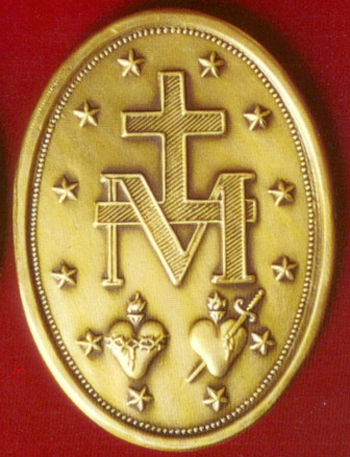 The other side of the Medal is no less symbolic. It contains the elements of various devotions that come together as a whole. We see a series of 12 stars as in the crown of Our Lady crushing the head of the Serpent of which the Apocalypse speaks: "And a great sign appeared in heaven: A woman clothed with the sun, with the moon under her feet, and on her head a crown of twelve stars" (12:1).
The other side of the Medal is no less symbolic. It contains the elements of various devotions that come together as a whole. We see a series of 12 stars as in the crown of Our Lady crushing the head of the Serpent of which the Apocalypse speaks: "And a great sign appeared in heaven: A woman clothed with the sun, with the moon under her feet, and on her head a crown of twelve stars" (12:1).
Then in the center is the M, which is the M of the name Mary. Above it and intertwining with it is a Cross. This reminds us very much of St. Louis Grignion de Montfort's Treatise of True Devotion in which he predicted the Reign of Jesus through Mary: “It is through the most Blessed Virgin Mary that Jesus Christ came into the world, and it is also through her that He will reign in the world.”
Then, below that M, we find the two hearts representing the two great devotions of the Sacred Heart of Jesus and the Immaculate Heart of Mary. These are graces given to us to face the modern times in the fight against the Revolution.
We have, then, the affirmation of the Immaculate Conception, a dogma that would be defined some decades later, and the devotions of the Sacred Heart of Jesus and of the Immaculate of Mary, which were given to avoid the Revolution in France. In the same light, the work of St. Louis de Montfort was also given to France to avoid the French Revolution. These devotions were given to Catholics so that they could fight against the Revolution and defeat it.
All these symbols come together as a type of compendium of the most sensible points of Catholic piety and the natural object of its best inclinations.
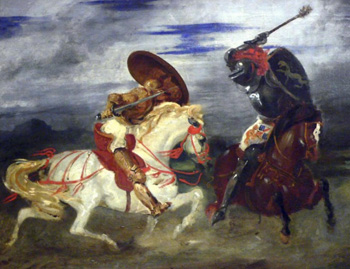 This is why the Miraculous Medal is the object of so many graces. For this reason we should love this Medal, seeing in it a type of blueprint for counter-revolutionaries. We should wear it always, have it with us always.
This is why the Miraculous Medal is the object of so many graces. For this reason we should love this Medal, seeing in it a type of blueprint for counter-revolutionaries. We should wear it always, have it with us always.
You can see that Catholic piety knows how arrange things, presenting this devotion at the opportune time. Another splendid devotion that Catholics have had since the Middle Ages is the Rosary. Thus, placing this Medal as its centerpiece, uniting the first and the last of the decades of the Rosary, is a most fortunate and harmonic idea. It thus constitutes a congruous whole that should speak much to us and increase our devotion to Our Lady.
Let us ask Our Lady that, through the graces of the Miraculous Medal, she hasten the day of her victory over the Revolution. Let us also ask that she help us to be faithful during the storms that are approaching. Let us always remember that perseverance is a priceless grace.
Indeed, what is it worth for us to have faith and the other virtues if we do not have perseverance? Perseverance is not a fruit of our personal qualities. It is the fruit of a grace that we should humbly request and insistently implore, and then correspond to it. We should, therefore, also ask for the graces that ensure perseverance.
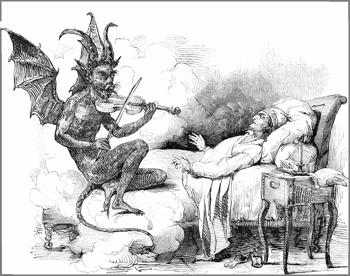 I do not remember which good author said that the devils of the air are so numerous that if they were to be seen, they would obscure the light of the midday sun. These are the devils who predispose souls to sin. They prepare the ambience for souls to accede to the temptations that the other devils – the devils of Hell – make to lead them into sin. If evil is so overwhelming today, it is because the psychological ambience is already prepared for man to sin.
I do not remember which good author said that the devils of the air are so numerous that if they were to be seen, they would obscure the light of the midday sun. These are the devils who predispose souls to sin. They prepare the ambience for souls to accede to the temptations that the other devils – the devils of Hell – make to lead them into sin. If evil is so overwhelming today, it is because the psychological ambience is already prepared for man to sin.
I have the impression that each one of us is tempted by the devils of Hell many times a day, and that these temptations are duly prepared by the devils of the air. So, we should understand that this Medal with all the symbols Our Lady desired to place on it is a pledge of her alliance with her true devotees.
The Miraculous Medal is a kind of shield for the fight against all the temptations of the Devil. The invocation of Our Lady of the Miraculous Medal along with the ejaculation it displays – "O Mary conceived without sin, pray for us who have recourse to Thou" – are particularly efficient in the fight we have to wage against the powers of darkness in our days.
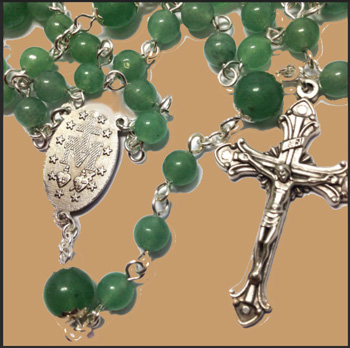


The Saint of the Day features highlights from the lives of saints based on comments made by the late Prof. Plinio Corrêa de Oliveira. Following the example of St. John Bosco who used to make similar talks for the boys of his College, each evening it was Prof. Plinio’s custom to make a short commentary on the lives of the next day’s saint in a meeting for youth in order to encourage them in the practice of virtue and love for the Catholic Church. TIA thought that its readers could profit from these valuable commentaries.
The texts of both the biographical data and the comments come from personal notes taken by Atila S. Guimarães from 1964 to 1995. Given the fact that the source is a personal notebook, it is possible that at times the biographic notes transcribed here will not rigorously follow the original text read by Prof. Plinio. The commentaries have also been adapted and translated for TIA’s site.

St Catherine Labouré, chosen by Our Lady to give the world the Miraculous Medal
It is, therefore, worthwhile for us to analyze the Medal and all that it symbolizes so that we may understand what Divine Providence had in mind when It bestowed so many graces on this Medal revealed to St. Catherine Labouré.
On one side of the Medal we have Our Lady standing atop the world, which is an affirmation of her Queenship over the entire Earth.
This same doctrine of the Queenship of Our Lady was re-affirmed at Fatima as a victory of the Counter-Revolution: "Russia will spread her error everywhere; the Pope will have much to suffer; the Church will be persecuted; finally, My Immaculate Heart will triumph." The Revolution will be defeated and we will have the victory of the Immaculate Heart of Mary.
Our Lady is also trampling on the Serpent, which is entirely coherent with the message of Fatima.
On this side of the Medal these words are written: "O Mary conceived without sin, pray for us who have recourse to Thou." This evidently refers to the Immaculate Conception.

At left, a depiction of the Immaculate Conception, at right, Our Lady of Graces as she appeared in the Miraculous Medal
Then, we have something that makes us think of the Universal Mediation of Our Lady. The graces come from God, but are all distributed through the hands of Our Lady and fall over the world in an enormous quantity.
The victory over the Revolution will come at the culminating apex of the vicissitudes of Holy Mother Church and, thus, as the realization of the Fatima prophecies.
Here we have a series of concepts that come together to give us a grandiose vision of the victory of Our Lady over the world.
These graces fall over the world for the conversion of the sinners and for the protection of those who are faithful until the end, but they are also for the chastisement of those who harden themselves to divine grace. These graces pour from the hands of Our Lady like a mountain spring. She is affable, smiling and welcoming to all those who address themselves with trust to her, asking for the graces they need.

Back of the Miraculous Medal
Then in the center is the M, which is the M of the name Mary. Above it and intertwining with it is a Cross. This reminds us very much of St. Louis Grignion de Montfort's Treatise of True Devotion in which he predicted the Reign of Jesus through Mary: “It is through the most Blessed Virgin Mary that Jesus Christ came into the world, and it is also through her that He will reign in the world.”
Then, below that M, we find the two hearts representing the two great devotions of the Sacred Heart of Jesus and the Immaculate Heart of Mary. These are graces given to us to face the modern times in the fight against the Revolution.
We have, then, the affirmation of the Immaculate Conception, a dogma that would be defined some decades later, and the devotions of the Sacred Heart of Jesus and of the Immaculate of Mary, which were given to avoid the Revolution in France. In the same light, the work of St. Louis de Montfort was also given to France to avoid the French Revolution. These devotions were given to Catholics so that they could fight against the Revolution and defeat it.
All these symbols come together as a type of compendium of the most sensible points of Catholic piety and the natural object of its best inclinations.

A shield given to men to fight the Revolution
You can see that Catholic piety knows how arrange things, presenting this devotion at the opportune time. Another splendid devotion that Catholics have had since the Middle Ages is the Rosary. Thus, placing this Medal as its centerpiece, uniting the first and the last of the decades of the Rosary, is a most fortunate and harmonic idea. It thus constitutes a congruous whole that should speak much to us and increase our devotion to Our Lady.
Let us ask Our Lady that, through the graces of the Miraculous Medal, she hasten the day of her victory over the Revolution. Let us also ask that she help us to be faithful during the storms that are approaching. Let us always remember that perseverance is a priceless grace.
Indeed, what is it worth for us to have faith and the other virtues if we do not have perseverance? Perseverance is not a fruit of our personal qualities. It is the fruit of a grace that we should humbly request and insistently implore, and then correspond to it. We should, therefore, also ask for the graces that ensure perseverance.

A devil of the air preparing a man for sin
I have the impression that each one of us is tempted by the devils of Hell many times a day, and that these temptations are duly prepared by the devils of the air. So, we should understand that this Medal with all the symbols Our Lady desired to place on it is a pledge of her alliance with her true devotees.
The Miraculous Medal is a kind of shield for the fight against all the temptations of the Devil. The invocation of Our Lady of the Miraculous Medal along with the ejaculation it displays – "O Mary conceived without sin, pray for us who have recourse to Thou" – are particularly efficient in the fight we have to wage against the powers of darkness in our days.


 | |
|
|
The texts of both the biographical data and the comments come from personal notes taken by Atila S. Guimarães from 1964 to 1995. Given the fact that the source is a personal notebook, it is possible that at times the biographic notes transcribed here will not rigorously follow the original text read by Prof. Plinio. The commentaries have also been adapted and translated for TIA’s site.


